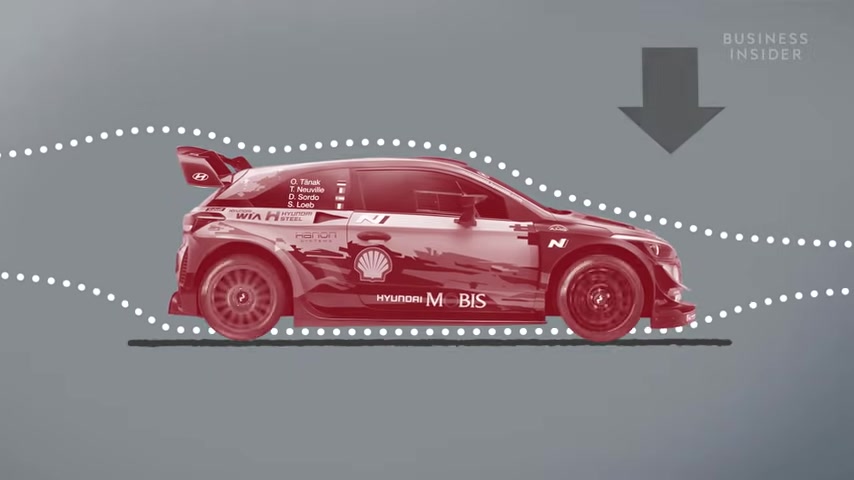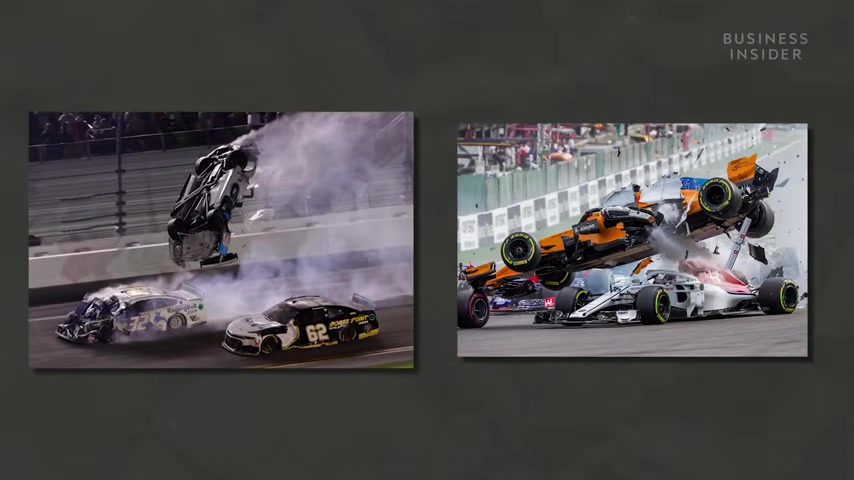https://www.youtube.com/watch?v=jY2qDbidnug
How Compact Cars Can Jump Football Fields In Rally Races

This is the longest jump ever made in the world rally championship 278 ft .
That's nearly the length of a football field .
That massive jump was done by this car .
A Citron C four , a simple European compact car known for its safety and reliability .
But how do you send an average economy car into orbit and safely back down again ?
You transform everything that makes it an average car .
The first important difference between rally cars and road cars is a more aerodynamic design that makes flying through the air a whole lot easier and safer .

Let's compare a rally car like Hyundai's I 20 WRC model and the automaker's I 20 compact car that it's based on besides both being built on the same steel shell , one screw race car while the other screams new parents .
But those eye catching editions aren't just for show once the I 20 takes flight .
Its aerodynamic editions , make sure it comes back down as soon as possible .
And on its wheels , this requires creating down force the downward vertical force on a car that keeps it glued to the ground in a sport like Indycar racing that takes place on a smooth flat tarmac , creating downward force is important for simply giving racers more grip in tight corners .

But in rallying where there's constant elevation changes on loose gravel and snow down force keeps cars from flying off the track to generate down force .
Rally cars like Hyundai's I 20 W R C are fitted with sloped carbon fiber wings throughout the body .
While most obvious is the six ft long one in the back .
There are also small wings positioned over the wheels .
These are known as dive planes , although they may be a different size and shape , their function is the same as the car drives forward at high speed .
It has to cut through air .
High pressure , air forced under the car creates an upward force on the vehicle known as lift .
The wings counteract this lift with down force , incoming air forced over the car is slowed down and pushed upward by the wings .

The equal and opposite reaction is slower moving high pressure air now pushing the car downward .
This the down force needed to keep the car properly balanced .
This down force is especially useful for jumps in a rally car that constantly finds itself in the air .
Having plenty of down force to stay level and coming straight back down on all four wheels is especially important .
Just ask driver Peter Solberg who lost his rear wing in the 2005 rally Finland .
But even if you can send a car flying into the air level and straight down on all four wheels , it means nothing .

If that car doesn't have a suspension that can handle the landing , that's why the suspension that ends up on a WRC rally car looks nothing like what you'll find on your typical road car , especially the dampers on a regular road car every time your car bounces over a rough surface or hits a nasty bump .
The intense energy and vibrations on your wheels are absorbed by a large coil spring .
But while those springs are great at absorbing energy , they need something in the way to keep them from bouncing back , uncontrollable like a trampoline .
That's where dampers come in positioned inside the spring .
They're made up of a long telescopic body with a piston and oil inside as the spring compresses during a heavy bump .
So does the damper and that piston slides down through the oil as the spring bounces back .
The damper is what keeps it under control .

The oil slows down the piston's return and converts that energy into heat on a road car .
The goal of the suspension and dampers is to keep the ride as smooth and comfortable as possible .
Ideally , so you barely notice those bumps at all .
But on a WRC rally car comfort is the engineer's last concern .
There's no question .
There are bumps and bangs coming .
You've got 1.2 tons of metal crashing down heights of over three yards .
The goal is for the car to survive and keep going as fast as possible .
This calls for dampers twice as big and strong so they can handle more intense compression .
They're built thick , heavy and tuned with the intention of absorbing an enormous impact , not making sure the passengers are cozy .
A motor sport like rallying also requires an additional canister connected to the damper .

In an especially active damper .
Oil , temperatures are reaching up to 248 degrees Fahrenheit .
This can cause your shock absorbers to overheat which leads them to compressing irregularly and the driver losing control of the vehicle .
An additional canister or remote reservoir allows you to carry more oil .
Have a place where it can cool down the most crucial feature .
Rally car dampers have though is how adjustable they are with knobs found on both the dampers and throughout the car , everything from ride height to compression speed can be adjusted for rally courses that feature more jumps .
Drivers need a car that's both higher off the ground with a suspension that they can count on bouncing back immediately .
But even if your car has the aerodynamics to soar through the air smoothly and a suspension that can handle the landing , it's going to mean nothing if your car's undercarriage isn't protected properly .

The undercarriage has many exposed components like fuel lines that are easily penetrable by sharp rocks and race debris .
So the I 20 WRC is fitted with quarter inch thick steel plates bolted to the underside of the car known as skid plates or sump guards .
Their main objective is to protect the oil pan transmission and fuel tank from loose stones and debris skid plates help drivers against a number of major car problems .
The most dangerous being fuel and oil leaks .
While these two issues usually just result in engine failure , they have also caused a number of major fires in the W R C escape's unsolved car fire at Marches rally , Mexico is believed to have been caused by an oil leak skid plates drastically improve your chances of avoiding them .
Still , the skid plate alone can't protect you from everything .

Just ask driver Elvin Evans who landed on nothing but his skid plate at last year's rally , Estonia and suffered two compression fractures no matter how prepared you may be .
Some rally car disasters are just unavoidable .
So while cars only take to the air in NASCAR and formula one , after something has already gone wrong in the world rally championship , it's a major part of the competition between being equipped with an aerodynamic body , heavy duty suspension and a steel plated undercarriage jumping nearly the length of a football field is something these incredible vehicles can handle day to day while they may be based on compact cars that can barely handle a pothole .
The right kind of engineering can transform them from family vehicles into high flying tanks
Are you looking for a way to reach a wider audience and get more views on your videos?
Our innovative video to text transcribing service can help you do just that.
We provide accurate transcriptions of your videos along with visual content that will help you attract new viewers and keep them engaged. Plus, our data analytics and ad campaign tools can help you monetize your content and maximize your revenue.
Let's partner up and take your video content to the next level!
Contact us today to learn more.